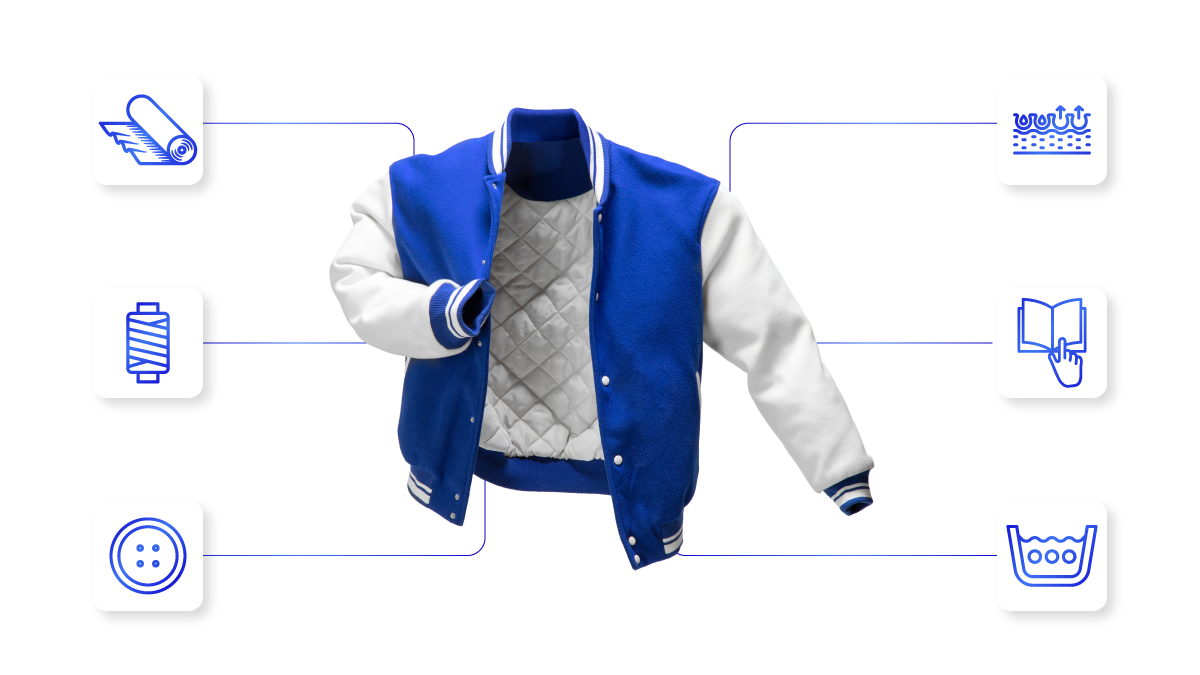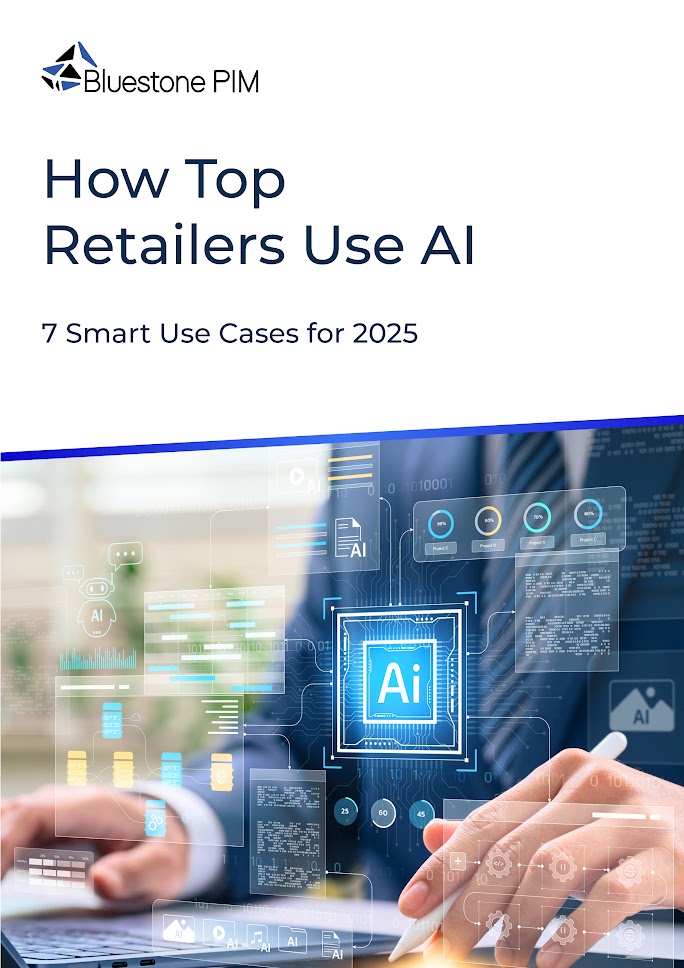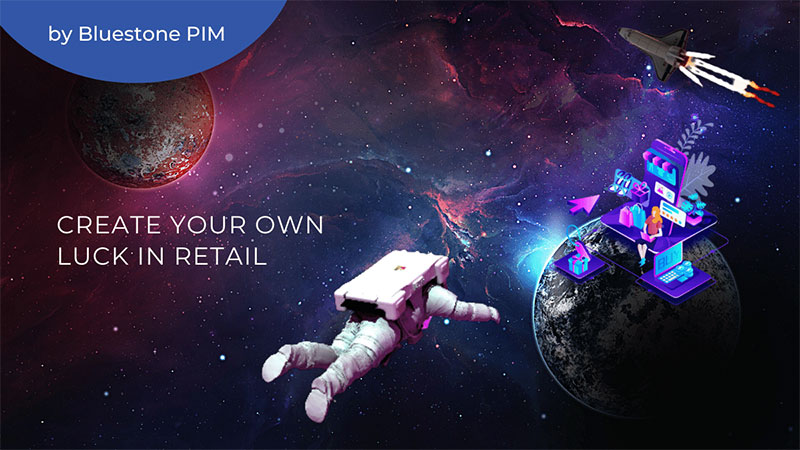Top 11 Retail Trends Reshaping the Industry in 2025 and Beyond

Table of Contents
- Trend #1: Phygital retail
- Trend #2 AI-powered personalisation
- Trend #3 The emergence of recommerce
- Trend #4 Frictionless delivery
- Trend #5 Augmented reality (AR)
- Trend #6 Creator commerce
- Trend #7 Contactless and frictionless payments
- Trend #8 Sustainable and ethical shopping
- Trend #9 "Quiet luxury"
- Trend #10 Voice commerce
- Trend #11 Supply chain resilience with blockchain
- Key insights
Managing thousands of SKUs in Ecommerce?
Get monthly tips to become the e-commerce pro your team needs.
The 2025 retail landscape is defined by two major consumer groups:
-
Picky shoppers who expect the best version of every product, tailored personalisation, and full data privacy.
-
Value-driven buyers who insist on affordability but refuse to compromise on quality, sustainability, or rapid delivery.
Retailers must adapt to a market shaped by changing consumer preferences, persistent price sensitivity, high inflation, global uncertainty, and the push for climate action.
Despite ongoing challenges, 2025 offers new opportunities. Retail supply chains are stabilising post-pandemic, and inflation is expected to drop to 2.4% in the US and 2.7% in Europe (Forbes), providing a more balanced environment.
However, price remains a top priority for most shoppers, even as economic optimism grows. To succeed, retailers need to anticipate shopper behaviour, deliver exceptional value, and leverage the latest commerce technology.
This guide explores the top 11 retail trends for 2025, helping you gain a competitive advantage today:
#1 Phygital Retail
Phygital retail, also known as hybrid shopping, is a key 2025 retail trend shaped by generational shifts in shopping behaviour. Baby Boomers often value the tangible experience of in-store shopping, while Gen Z prefers the speed and convenience of digital channels.
Today’s most successful retailers bridge both worlds:
-
95% of consumers review products online before making a purchase
-
58% are willing to pay more for products from brands with positive reviews (Globenewswire)
This generational divide means phygital retail is now essential for brands that want to meet the expectations of all shoppers.
A modern phygital experience can include:
-
Browsing products online, then receiving personalised recommendations in-store based on your digital browsing history
-
Checking in-store stock instantly from your mobile device
-
Using click-and-collect, reserve online, and Augmented Reality (AR) features for interactive shopping
In 2025, retailers are using advanced product information management and real-time analytics to keep inventory, customer data, and sales channels synchronised. Composable, API-first platforms such as Bluestone PIM help deliver a unified commerce journey, supporting omnichannel shopping and smart personalisation.
Example:
Nike is leading the way in unified commerce by using Augmented Reality to merge digital product discovery with the in-store experience, setting a new standard for phygital retail.

More on that one in trend #5.
#2 AI-Powered Personalisation
AI continues to transform the retail industry in 2025. Retailers are now using AI to create highly personalised shopping experiences and smarter product recommendations across every channel.
Despite frequent media debates around AI and data privacy, younger consumers are generally positive. According to recent research, 65 percent of Generation Z feel enthusiastic about AI’s progress and see it as a benefit to society.
How does AI work in retail?
Machine learning algorithms analyse large volumes of customer data from e-commerce platforms, social media, and loyalty programmes. This analysis helps retailers understand consumer preferences, predict behaviour, and recommend tailored products for each shopper.

DOWNLOAD FREE E-BOOK
How Top Retailers Use AI - 7 Use Cases
Get the insider playbook with proven tactics, real case studies, and ready-to-use tools that turn AI from buzzword to bottom-line results.
Examples of AI in everyday retail include:
-
Loyalty apps that send you promo codes or complementary product offers based on your buying history
-
Product recommendations on e-commerce sites, personalised emails, and dynamic pricing
-
Chatbots and voice assistants that streamline support and shopping
Many small and mid-sized retailers worry that the high cost of AI and machine learning could make it harder to compete. However, as the technology matures and becomes more accessible, innovative solutions are emerging that level the playing field.
Platforms like Bluestone PIM are designed to bring AI-driven personalisation and analytics to retailers of all sizes. With cloud-based, API-first architecture, even smaller brands can deliver intelligent, personalised commerce experiences without the need for massive investment.
#3 The Emergence of Recommerce
Recommerce, also known as “resale commerce”, is becoming one of the most influential retail trends for 2025 and beyond.
According to Insider Trends, a “resale boom” is expected this year, with both major and niche retailers entering the recommerce market to address growing demand for sustainable shopping options.
Platforms such as Vinted, Vestiaire Collective, and Depop are seeing rapid growth as more consumers turn to second-hand marketplaces for value and environmental reasons.
Leading UK retailers are responding to this shift. Selfridges has set a target for half of its sales to come from resale, repair, rental, or refill services by 2030. Brands like H&M and Uniqlo are also dedicating more floor space to rental and resale initiatives.x
Zalando is recognised as an early leader in recommerce, having launched its “pre-owned” category in 2020. The popularity of recommerce is driven by two main factors:
-
Consumer demand for sustainable choices, particularly among younger generations. Seventy percent of Gen Z shoppers consider sustainability a key factor when purchasing fashion.
-
The desire to declutter and curate wardrobes, making it easier for customers to access quality items without excess.

Recommerce is evolving from a simple sustainability add-on to a central profit driver for retailers. As the resale market matures, it is set to transform not only how retailers sell but also how they manage product data, logistics, and omnichannel experiences.
#4 Frictionless Delivery: The New Standard in Retail
Frictionless delivery is now the gold standard for e-commerce in 2025. This approach focuses on delivering orders quickly, conveniently, and with minimal effort from the customer. Retailers who master frictionless delivery gain a significant competitive advantage.
What is frictionless delivery?
Frictionless delivery means integrating advanced technology and logistics partnerships to offer rapid, reliable order fulfilment; often within the same day or even the same hour. The goal is to remove every barrier between online purchase and doorstep delivery.
Why Fast, Convenient Delivery Matters
-
Modern consumers increasingly base purchase decisions on delivery speed and reliability.
-
Same-day or “within the hour” delivery has become a differentiator, especially in urban areas.
-
Many shoppers are willing to pay extra for guaranteed fast delivery.
How Retailers Achieve Frictionless Delivery
-
Invest in automated fulfilment centres and real-time order tracking.
-
Use data-driven logistics partners for efficient routing.
-
Leverage innovative solutions such as drone delivery, which automates and accelerates the delivery process.
-
Global retailers like Amazon and Walmart are expanding drone delivery and micro-fulfilment networks in 2025.

#5 Augmented Reality (AR)
Augmented Reality (AR) is changing how shoppers discover and choose products: both online and in-store.
Why AR Matters in Retail
-
71% of shoppers say they are more likely to shop more often when using AR apps (Deloitte).
-
40% of consumers are willing to pay more if they can test a product with AR first.
Why is this important?
AR helps customers make better decisions and reduces product returns, saving money for retailers.
How Brands Are Using AR
-
Nike: Lets customers customise and virtually try on trainers with a 360-degree digital preview.
-
IKEA: Offers an app for customers to virtually place furniture in their homes.
-
BYX and Urban Decay: Use Instagram filters for AR-powered virtual makeup try-ons.

Benefits for Retailers
-
Fewer returns and exchanges
-
Higher customer confidence
-
Enhanced personalisation
-
Fun, shareable shopping experiences
#6 Creator Commerce
Creator commerce, sometimes known as social commerce, is a dominant retail trend for 2025. Social platforms such as YouTube, Facebook, Instagram, and TikTok have made shopping a natural extension of everyday online interactions. Consumers can now discover, review, and purchase products directly within their favourite social apps!
How creator commerce is reshaping retail:
-
Users explore products, read reviews, and buy; all without leaving the social network (for example, Instagram Shopping).
-
Content creators and influencers act as authentic brand advocates, presenting products through genuine endorsements.
-
This authenticity helps build trust, shapes perceptions, and influences buying decisions.

Why should retailers embrace creator commerce?
Retailers who welcome content creators as integral members of their brand community unlock a powerful marketing channel. Creators can introduce products to new audiences, foster brand loyalty, and create a sense of belonging among consumers.
According to Goldman Sachs, the creator economy market is expected to double by 2027, reaching $480 billion globally.
An estimated 50 million creators are predicted to grow at a 10 to 20 percent compound annual growth rate over the next five years. The influencer trend is not a fleeting one; it is set to grow stronger, with social shopping becoming an everyday habit for millions.
Example:
Kylie Cosmetics by Kylie Jenner is a leading case study in creator commerce. By leveraging Instagram followers and personal branding, Kylie Jenner built direct, authentic engagement with her audience. This approach helped drive millions in sales and briefly made her the youngest self-made billionaire, as reported by Forbes.
To succeed with creator commerce in 2025, brands need:
-
A strong product information management platform, such as Bluestone PIM, to ensure creators always have access to accurate, up-to-date product details for social campaigns.
-
The ability to quickly syndicate rich media, product attributes, and reviews across social channels and influencer storefronts.
-
Tools for tracking campaign effectiveness and connecting social engagement with sales performance.
#7 Contactless and Frictionless Payments: The Future of Retail Transactions
Contactless and frictionless payment methods are now at the forefront of retail innovation, as digital transactions become the standard in 2025.
How do contactless payments work?
Technologies like near-field communication (NFC) power systems such as Apple Pay and Google Pay. Customers simply tap their contactless-enabled card, smartphone, or wearable on a compatible terminal, removing the need for physical contact or inserting a card.
Frictionless payment in-store:
Retailers are implementing scan-and-go systems, allowing shoppers to scan items with their smartphones and check out instantly, without waiting in queues. Solutions like Amazon’s “Just Walk Out” technology use cameras and sensors to track what customers select, so they can leave the store and be automatically charged for the items they take.
Biometric payments and the rise of facial recognition:
Contactless payments now go beyond cards and phones. Some retailers are introducing biometric authentication, such as fingerprint scanning or facial recognition, enabling customers to pay with their face or a touch. This adds another layer of security, though it raises privacy concerns in many regions.
Example: Carrefour supermarkets in the UAE let shoppers pay by simply smiling at the checkout, using facial recognition technology. However, in Europe, such methods face regulatory hurdles. As of June 2023, the EU Parliament has voted for a complete ban on live facial recognition in public spaces, making widespread adoption less likely in the near term.
#8 Sustainable and Ethical Shopping
Sustainable and ethical shopping is now a central focus for both consumers and retailers. Shoppers are more aware than ever of the environmental and social impact of their purchasing decisions, and expect brands to operate responsibly at every stage of the product lifecycle.
How are retailers responding?
Retailers are embedding sustainability across their operations, from ethical sourcing and supply chain management to recyclable packaging and energy-efficient logistics.
Legislation and innovation driving change:
New regulations such as the Digital Product Passport are set to transform industries including fashion, apparel, and electronics. These passports promote material traceability, energy efficiency, and transparent reporting.

DOWNLOAD FREE E-BOOK
Digital Product Passport Compliance: The Deadline Every Business Must Meet
DPP compliance is mandatory in the EU. Don't risk your business on guesswork. Get the only guide you need to navigate DPP regulations confidently and completely.
The role of technology and PIM platforms:
B2B technology vendors now offer advanced traceability solutions that improve sustainability standards. Product Information Management (PIM) systems, such as Bluestone PIM, empower retailers to:
-
Centralise and manage accurate, real-time product data
-
Forecast demand and minimise overstock, reducing waste
-
Communicate eco-friendly product attributes to consumers, supporting informed, sustainable choices
Sustainability is no longer a “nice to have” but a business-critical strategy executed under close consumer scrutiny. Brands must ensure that their sustainability claims are accurate and verifiable.
#9 “Quiet Luxury”
Quiet luxury is redefining premium retail in 2025. Consumers are choosing products that showcase sophistication through understated design, premium materials, and exceptional craftsmanship, rather than overt branding or logos.
What defines quiet luxury?
Brands like Hermès exemplify this trend, creating iconic products such as silk scarves that are recognised not by prominent logos, but by their intricate patterns, quality fabrics, and expert production. Quiet luxury is about intrinsic value and timeless appeal.
Personalised and exclusive experiences:
Retailers are taking quiet luxury beyond products, offering tailored customer experiences that evoke exclusivity and connection. Examples include:
-
Limited-edition product launches
-
Personalised services and styling consultations
-
Invitation-only shopping events and previews
Ethical and sustainable luxury:
Quiet luxury in 2025 is closely linked to ethical sourcing and sustainability. Discerning consumers expect brands to adopt eco-friendly materials, transparent supply chains, and responsible manufacturing processes. Retailers are responding with:
-
Use of sustainable fabrics and dyes
-
Clear communication of supply chain origins
-
Practices that prioritise longevity over fast fashion
#10 Voice Commerce
Voice commerce is rapidly becoming a major retail trend in 2025, thanks to the growing popularity of smart speakers and virtual assistants. Voice-activated technology is transforming how consumers shop, offering a seamless, hands-free way to browse, compare, and purchase products.
How does voice commerce work?
Retailers are adopting conversational shopping assistants powered by voice recognition and artificial intelligence. These virtual assistants can:
-
Understand and respond to spoken queries
-
Recommend products based on customer preferences
-
Guide users through every step of the shopping journey
For example, Amazon's Alexa Shopping Assistant enables customers to add items to their basket, track deliveries, and receive personalised product suggestions using only voice commands. Similarly, Google Assistant's voice-driven product search helps users quickly discover relevant items without typing or tapping.
Why are retailers investing in voice commerce?
Integrating voice commerce into e-commerce platforms provides:
-
Greater convenience for busy shoppers
-
An inclusive, accessible shopping experience for those who prefer hands-free interaction
-
Opportunities for brands to engage customers in new, personalised ways
#11 Supply Chain Resilience with Blockchain
Blockchain technology is rapidly transforming supply chain management in 2025. Its decentralised, tamper-resistant ledger system provides a transparent and secure way to record and verify every transaction along the supply chain.
How does blockchain improve retail supply chains?
By creating a secure digital record of each step—from raw material sourcing to final sale—blockchain technology enables:
-
Full product traceability
-
Real-time tracking of goods and components
-
Faster, more efficient auditing
-
Reduced risk of counterfeiting
A leading example is Walmart, which uses blockchain to monitor its food supply chain. This allows the company to track products from farm to shelf with precision. If a food safety issue arises, Walmart can quickly identify the source and implement targeted recalls, protecting both consumers and the brand.
Benefits of blockchain in retail supply chains include:
-
Enhanced transparency for brands and customers
-
Streamlined compliance with regulations
-
Improved consumer trust through verifiable product origins
-
Greater security and accountability throughout the network
Key Insights: Why Tracking Retail Trends Drives Success in 2025
Retailers who continuously monitor and respond to emerging trends are better equipped to enhance customer experience, optimise operations, and introduce innovative strategies that keep their brand relevant.
Three key reasons to track and adopt retail trends:
-
Adaptability: Retailers can quickly adjust their products, services, and operations to match evolving consumer preferences, ensuring continued relevance and appeal.
-
Competitive advantage: By embracing the latest retail trends, businesses differentiate themselves from competitors and attract customers searching for new and innovative experiences.
-
Customer satisfaction: Incorporating retail trends allows businesses to exceed customer expectations, deliver exceptional shopping experiences, and foster lasting loyalty.
In 2025 and beyond, proactively embracing retail trends will empower your business to delight customers, stay agile, and achieve sustainable success. To discover more proven strategies for enhancing customer experience, download our Customer Experience (CX) ebook:

DOWNLOAD FREE E-BOOK
The Art and Science of Customer Experience
Over 50 pages of expert advice and top CX tips.
Ready to elevate your product content strategy? Connect with our PIM advisors today to book a personalized demo meeting and explore the limitless possibilities of Bluestone PIM.




![6 Pivotal Benefits of AI for Retail [+ Use Cases from Top Brands]](https://www.bluestonepim.com/hubfs/6-Pivotal-Benefits-of-AI-for-Retail-1.png)